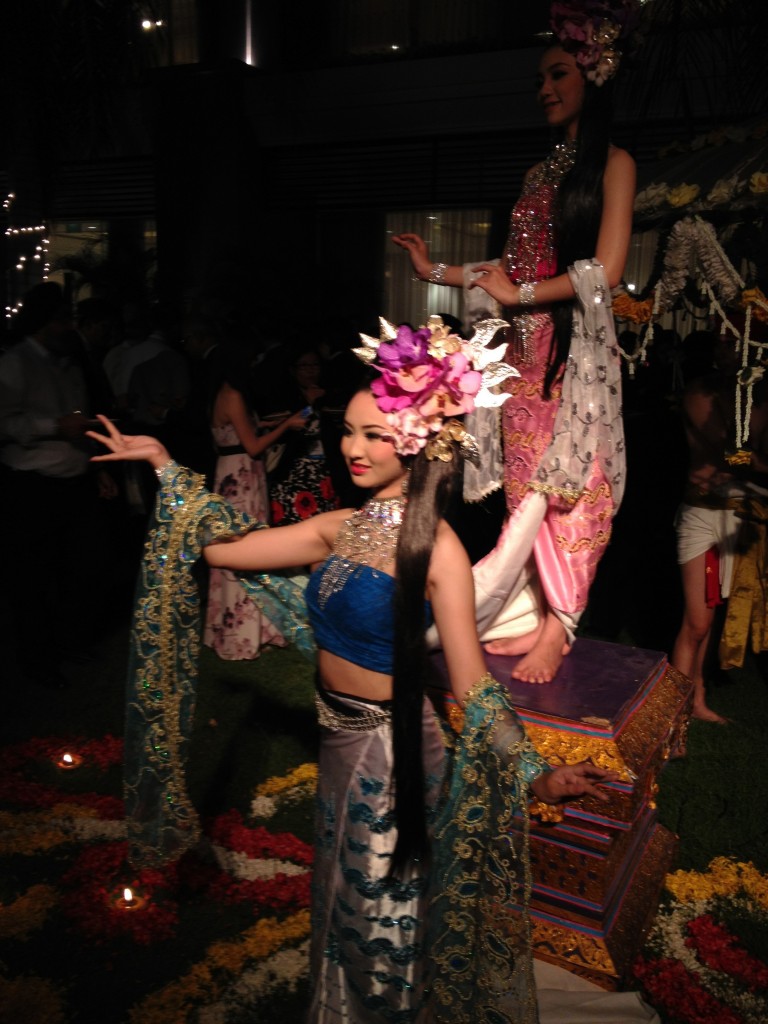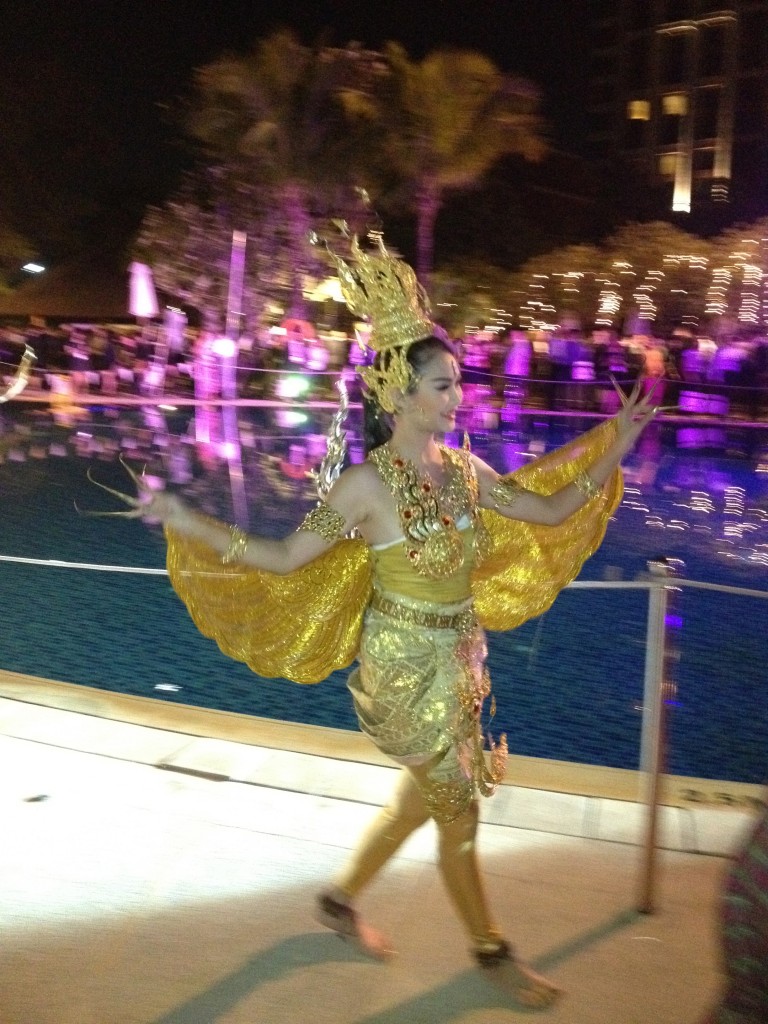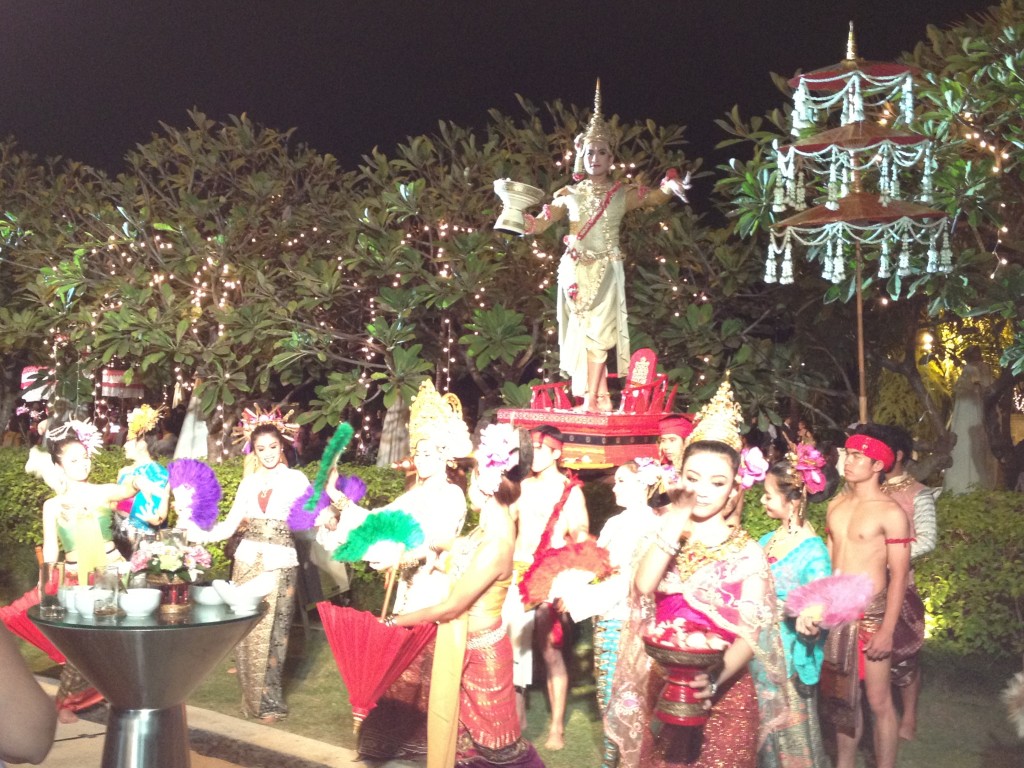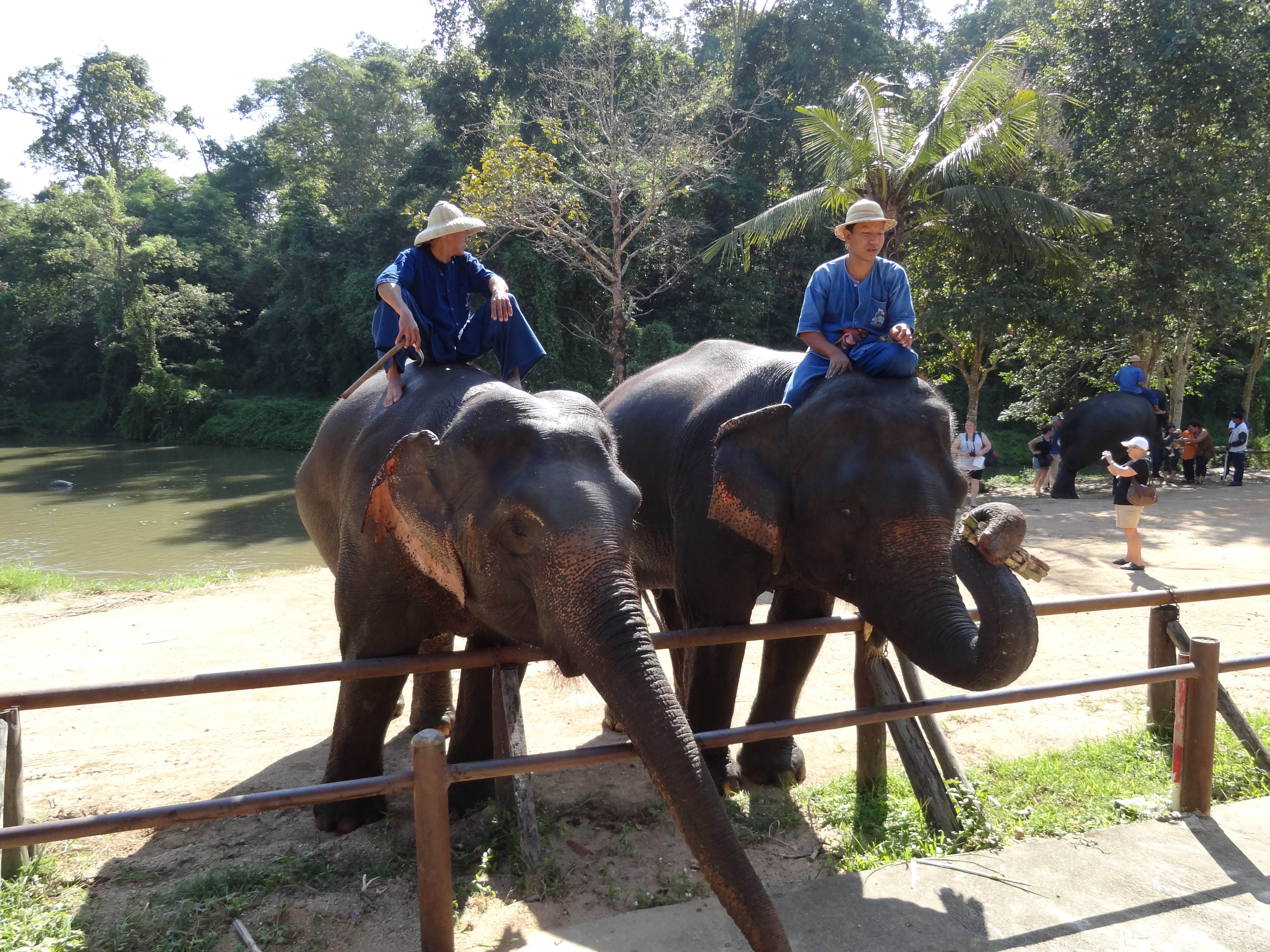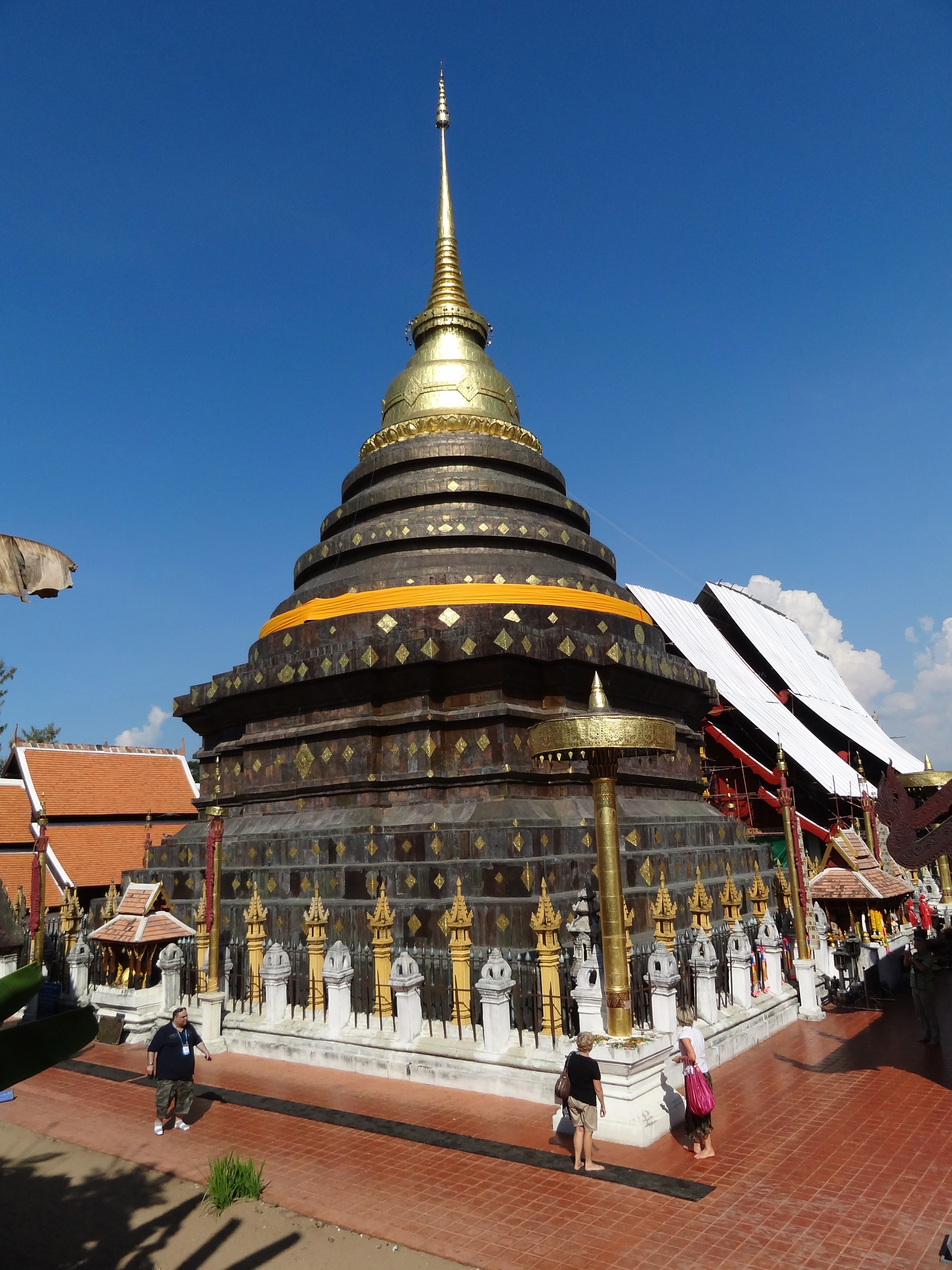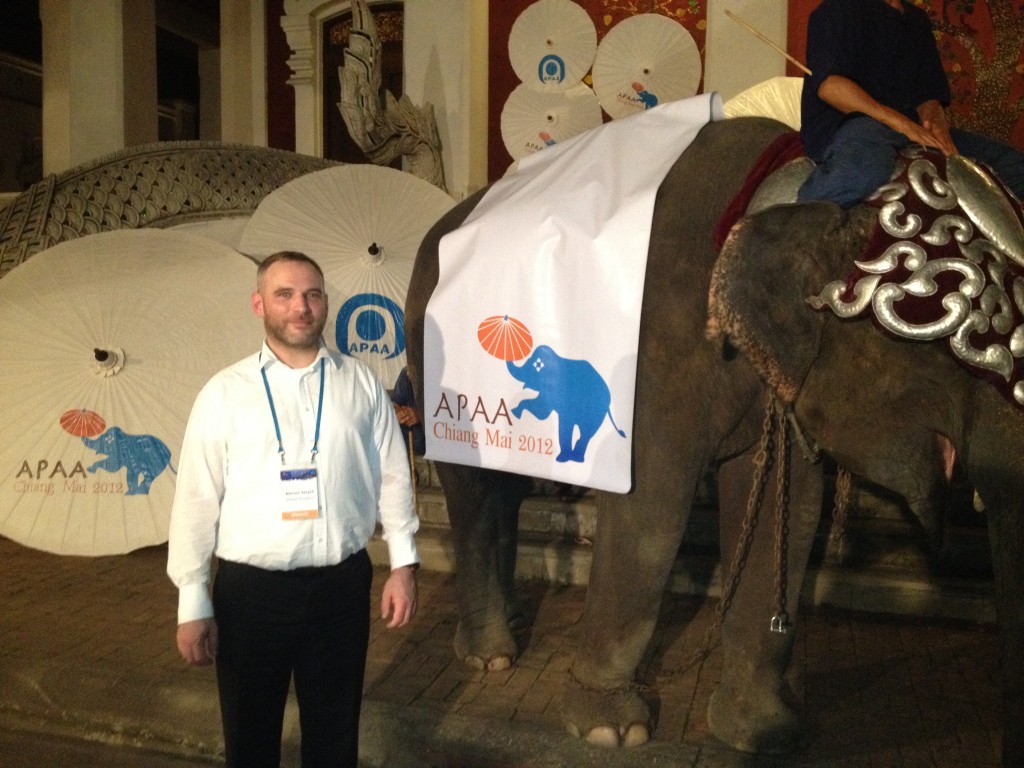APAA 2012 Photos from Opening Night
0October 31, 2012 by IPAlchemist
Finally I got round to reviewing the photos. Many did not turn out as well as I hoped, but here are a few. My limited photography skill and unsophisticated equipment did not cope well with artificially lit nighttime scenes… But you get the idea.
Category IP (Intellectual Property), Travel | Tags: APAA, dance
Chiang Mai APAA 2012 Day 3
0October 30, 2012 by IPAlchemist
Main news – we have discovered a new tweeter – welcome to @antonblijlevens.
Today was excursion day – Elephants (the Elephant Conservation Centre) and Temple (the Pagoda of the Wat Phrathad Lampang Luang). So I attach one photo of each.
A picture tells a thousand words, so I shall leave it at that.
Category IP (Intellectual Property), Travel | Tags: APAA, Elephant, Temple
The APAA Elephant
0October 29, 2012 by IPAlchemist
OK, I could not wait. Here is the APAA elephant. With me. Looking hot and flustered and British. Because I am British and I don’t deal with the heat very well. Sorry.
But shout out to Bruno Nunes, my new friend and fellow tweeter from Macao, for taking the picture.
If there are any other tweeters out there, let us know, as Bruno and I are feeling lonely.
Category IP (Intellectual Property), Travel | Tags: APAA, Elephant
Chiang Mai APAA 2012 Day 2
2October 29, 2012 by IPAlchemist
So, the beginning of Day 2.
I am ignoring the official programme (so shoot me – I was in very good company). Had to catch up with blogging, and the home emails which didn’t stop just because I was in Thailand, unfortunately…
…and of course I had to meet lots of delegates.
I have been really struck by how friendly this conference is. While I am not particularly experienced at big international IP conferences, I am experienced about rooms full of patent attorneys, and they (we) are generally a shy bunch, and rather reserved. Here, I have been astonished by how freely people will come up to you and introduce themselves, whether at the social events in the evenings, or just during the day in the lobby. This has led to meeting many interesting people in addition to the ones I had planned to meet.
So now I am at the end of Day Two.
The evening reception in the grounds of the Mandarin Oriental has been amazing. Strewn everywhere were little stalls where people were making delicious pieces of gorgeousness to eat, so we just wandered round and had a little of each. Meanwhile, more fantastic performances with amazing costumes of all varieties, including men performing comic mock Thai boxing (at least that is what I think it was).
And there was an elephant. A real live elephant, bedecked in the APAA emblem. How many international conferences get to have their own elephant mascot? Our hosts here in Thailand have done us proud with a most wonderful show of hospitality.
I have some pictures again, but many have not come out well due to the difficulties of shooting in the dark a floodlit stage.
Dear readers will have to wait a little longer for the snaps, but I will post them I promise. But for now I have to call it a night, as I have an early start for a visit to an elephant sanctuary tomorrow.
Category IP (Intellectual Property), Travel | Tags: APAA
Chiang Mai APAA 2012 Day 1
0October 29, 2012 by IPAlchemist
Well, the first day has been as amazing as I imagined. When you get to the conference hotel, two floors of lobby area teeming with patent attorneys from all round the world. Quite an astonishing sight. All with our distinctive name signs hanging round our necks on turquoise lanyards.
Of course there is a goody bag. It contains a baseball cap and a polo shirt (the latter expected, as you had to give your chest size when registering), but both of questionable taste, at least to a fussy brit. For us, of course, poor taste is a sin almost on a par with queue-jumping. But the conference bag also contained hand sanitizer and insect repellant. Hand sanitizer? What are they trying to tell us?
There then followed a series of productive meetings over which I will draw a veil of discretion, except to note that EVERYONE seemed, like me, to be meeting someone on the hour, every hour, at the Lobby/Concierge desk of the main conference hotel, which therefore resembled a sea of bemused faces. Astonishingly, everyone, including me, did actually seem to eventually find who they were looking for, although sometimes it took a few minutes and a few false “Are you…???” [finally gets to read name badge] “Oh no sorry”.
We all have name badges, huge ones, dangling, as I said, with our names and country, as well as status (“Observer” for me), but not our firm’s name. But sometimes the jacket covers them, or they get turned round. But it does assist generally in avoiding the more terrible embarrassing faux pas. (What is the plural of “faux pas”?)
Although all of the events on the Sunday were marked as “smart casual” dress code, most people wore suits. I opted for open shirt and dark trousers, leaving the suit for Monday. Even then, I was warm enough!
Chairs and tables at which to sit were at a premium. Old hands, with multiple delegates per firm (not observers then, who are restricted to one observer per firm) left one member to guard the table while others went to look for the next meeting candidates. I didn’t, but generally found those I was meeting had, so it all worked out well in the end, and we always managed to find somewhere decent to chat.
Then at 5pm it was time to be off to the “New Participants Welcome”. I thought this would be some kind of lecture. But actually it was a party, with minimal speeches at the beginning, and lots of food (which although it looked lovely was not so appealing so soon after lunch). Everyone was very keen to meet new people and very friendly.
No sooner than that was over then it was time for the main opening ceremony. Some spectacular Thai drumming opened it, of which I was unfortunately unable to get a good photo. Then the obligatory speeches. Francis Gurry, Director of WIPO, who was unable to attend in person, gave speech by video link.
Then immediately on to the Welcome Reception. This was a vast affair – I understand there were about 2000 participants, and it certainly felt like it. Food was laid out in huge arrays around the hotel grounds. Thai dancers stood in gently moving tableaux. But it was outside, so no air conditioning, so even in shirt without jacket or tie I was sweltering (as, it has to be said, most of the North European participants seemed to be). There were period performances – more Thai dancing, fire dancing, all going on intermingled with the crowds, culminating in a farewell performance at the end. In among this, people managed to continue to eat, meet, polish off the vast amount of food, and not fall into the pool. (I did get some snaps of the dancing, which I will download and post later).
Although the Hospitality Suite was open, and the inimitable APAA band was getting ready to perform, I decided to call it a night. Too jetlagged even to finish this blog post (which I am posting the next morning), I took the coach back to my hotel and fell into bed.
Category IP (Intellectual Property), Travel | Tags: APAA
Chiang Mai APAA 2012 Day Zero
0October 27, 2012 by IPAlchemist
Just a holding post today.
Uneventful trip – BA to Bangkok and then Thai Airways for Chiang Mai. All passed without a hitch.
Have run into patent attorneys already – shout out to David Musker who I saw on the plane that I came on to Chiang Mai, so I hope we might get some designs discussions going on, what with the tablet wars being so topical.
I saw two dear Japanese patent attorney acquaintances, one from a long time ago and one from more recently, also on the same flight as me to Chiang Mai, who I shall not be so indelicate as to name here. But from the conversations going on in the departure gate, there were many many of us on that flight.
So tonight is just about getting myself settled in and ready for tomorrow when the real fun begins.
Clothes – ready; business cards – ready; schedule – ready; smartphone (for tweeting) – ready. So I am all set.
Watch out for tweets and a blog again tomorrow.
Category IP (Intellectual Property), Travel | Tags: APAA
Apple v Samsung – the publication of judgement revealed!
1October 26, 2012 by IPAlchemist
Apple’s homepage now includes a link to a page reporting the Court of Appeal and first instance judgement in the design case.
The wording includes the Court of Appeal wording, but goes a lot further, and highlights the other cases that have gone in Apple’s favour (but these do not relate to this registered design).
Full wording is as follows, in which sections NOT mandated by the Court of Appeal are in italic. It will be clear that they change the tone of the acknowledgement considerably.
Samsung / Apple UK judgment
On 9th July 2012 the High Court of Justice of England and Wales ruled that Samsung Electronic (UK) Limited’s Galaxy Tablet Computer, namely the Galaxy Tab 10.1, Tab 8.9 and Tab 7.7 do not infringe Apple’s registered design No. 0000181607-0001. A copy of the full judgment of the High court is available on the following link www.bailii.org/ew/cases/EWHC/Patents/2012/1882.html.
In the ruling, the judge made several important points comparing the designs of the Apple and Samsung products:
“The extreme simplicity of the Apple design is striking. Overall it has undecorated flat surfaces with a plate of glass on the front all the way out to a very thin rim and a blank back. There is a crisp edge around the rim and a combination of curves, both at the corners and the sides. The design looks like an object the informed user would want to pick up and hold. It is an understated, smooth and simple product. It is a cool design.”
“The informed user’s overall impression of each of the Samsung Galaxy Tablets is the following. From the front they belong to the family which includes the Apple design; but the Samsung products are very thin, almost insubstantial members of that family with unusual details on the back. They do not have the same understated and extreme simplicity which is possessed by the Apple design. They are not as cool.”
That Judgment has effect throughout the European Union and was upheld by the Court of Appeal on 18 October 2012. A copy of the Court of Appeal’s judgment is available on the following link www.bailii.org/ew/cases/EWCA/Civ/2012/1339.html. There is no injunction in respect of the registered design in force anywhere in Europe.
However, in a case tried in Germany regarding the same patent, the court found that Samsung engaged in unfair competition by copying the iPad design. A U.S. jury also found Samsung guilty of infringing on Apple’s design and utility patents, awarding over one billion U.S. dollars in damages to Apple Inc. So while the U.K. court did not find Samsung guilty of infringement, other courts have recognized that in the course of creating its Galaxy tablet, Samsung willfully copied Apple’s far more popular iPad.
Category IP (Intellectual Property) | Tags: Apple, publicity order, registered design, Samsung, tabletwars
Chem Coach Carnival – Patent Attorney
1October 24, 2012 by IPAlchemist
Chemistry blogger See Arr Oh is hosting a blog carnival in celebration of the 25th National Chemistry Week.
I missed getting this out in time for Mole Day yesterday, but I am still within the prescribed octave. So here is my contribution, following his prescribed outline.
My current job.
I am a patent attorney, partner in the intellectual property law firm EIP, and head of its chemistry practice group, EIP Elements. This covers pharmaceuticals, food science, process chemistry, polymers, agrochemicals, batteries, inks, and all sorts of other fascinating things.
What I do in a standard “work day.”
A lot of reading of patent documents and other “prior art” (which can be journal articles, abstracts…). A lot of writing as well: huge volume of emails; drafting patent documents; writing letters to the patent office, or other patent attorneys in other countries; and of course writing to my clients giving opinions, advice, and reports.
Although the work runs the danger of being solitary, I make it collaborative by talking to my colleagues – getting second opinions, arguing over obscure rules of grammar or punctuation, or discussing knotty legal problems.
There is quite a lot of travelling – I get to go to Japan and the USA quite regularly, and Munich (the seat of the European Patent Office) often. My favourite place to visit has been Jurong Island in Singapore, which is a vast agglomeration of chemical plants and an amazing sight.
What kind of schooling / training / experience helped me get there?
The chemistry degree was essential – you cannot even train as a patent attorney in Europe without a science or engineering degree, and you can only practise in a technical field that you understand. It was probably also important that I was interested in topics outside science – English language and literature and other languages especially, as literacy is a key aspect of being an effective patent attorney.
I did a DPhil and a post-doc – these were not perhaps so essential, although I do think that it helps me as a patent attorney that I understand a little of what it is like to do actual research. In the long term, the most important thing about the post-doc was probably that it was in Japan, so I learned Japanese. Many people enter the patent attorney profession after an undergraduate degree.
How does chemistry inform my work?
It is there all the way through – in particular the nomenclature aspects – you cannot claim a class of compounds if you don’t know how to name them correctly. It was probably teaching 1st year organic chemistry to biochemistry undergraduates that really hammered nomenclature into my head. I rely on the inventors most of the time for the detailed technical input, but I have to have the general background knowledge to understand this.
Being in private practice (rather than working in-house in a particular company) I get a lot of variety in the technical fields that I work in, and I really love that. My main reason for moving away from the research path was the monotony.
Finally an anecdote
My entry into the patent world was by a series of accidents. I heard about it when I was a teenager when my mother had an idea (a heater for the windscreen wiper reservoir to prevent freezing) and consulted a patent attorney about it. I mentioned that I was interested in the patent attorney career to a student doing a DPhil in the same lab as me when he was planning to enter the profession, and when he left his job to emigrate, he contacted me to ask whether I would be interested in the vacancy. A partner was visiting Japan where I was doing my post-doc at the time, and the job was then mine! People nowadays are a bit more methodical about it all, I think.
Category Chemistry, IP (Intellectual Property), Patents | Tags: career, Chem Coach Carnival, patent attorney
Apple v Samsung in the Court of Appeal – the end of Cool? (Reuters)
0October 18, 2012 by IPAlchemist
I went to the Court of Appeal this morning for the handing down of the decision in Samsung v Apple – which could be the last word in the dispute between the parties, insofar as it relates to the design of tablet computers within the EU.
The decision itself is now available electronically here.
I sent an immediate comment on the piece to the IPKat, which you can see here.
What was new for me, however, was getting talking to a Reuters reporter, Stephen Eisenhammer, who then rang me later to discuss the case. As a result I have been extensively quoted. The original Reuters piece says:
“I expect this will be the end of the line. An appeal to the Supreme Court is in principle possible but there has been no indication so far that Apple plan such an appeal”, Darren Smyth partner at EIP, a specialist intellectual property law firm, told Reuters.
“For the design of tablets in Europe this should be the final word.”
(You can see the full article here).
This has now been extensively picked up by publications around the world, and I have seen it translated into Spanish, Portuguese, and German.
I have just got off the phone to Dow Jones, so will be interesting to see where it leads…
The original decision stands (Samsung does not infringe Apple’s Community Registered Design). This decision applies throughout the EU, not just in the UK. Apple have to publish the decision in three national newspapers, the Financial Times, the Daily Mail and The Guardian, and in two trade magazines, Mobile Magazine and T3 magazine, in the following terms:
On 9th July 2012 the High Court of Justice of England and Wales ruled that Samsung Electronic (UK) Limited’s Galaxy Tablet Computers, namely the Galaxy Tab 10.1, Tab 8.9 and Tab 7.7 do not infringe Apple’s registered design No. 0000181607-0001. A copy of the full judgment of the High court is available on the following link [link given].
That Judgment has effect throughout the European Union and was upheld by the Court of Appeal on ….. A copy of the Court of Appeal’s judgment is available on the following link […]. There is no injunction in respect of the registered design in force anywhere in Europe.
This must be published in a font size no smaller than Arial 14pt and appear on a page earlier than page 6. And a link to this must appear on Apple’s homepage.
And unless there is an appeal to the Supreme Court (who are not obliged to hear any appeal), then this seems to be the end of the line for the design dispute on tablets in Europe for these parties.
UPDATE at 6.30pm:
The Dow Jones conversation led to a quotation in this article in the Wall Street Journal:
Darren Smyth, patent and design attorney at law firm EIP, said the ruling also covered disputes over design in other European courts.
“The Court of Appeal’s ruling is valid across the European Union because Apple’s registered design was a European Union-wide right. In these circumstances, the High Court and the Court of Appeal have …jurisdiction for the whole of the E.U., not just the U.K.,” Smyth said.
Category IP (Intellectual Property), News | Tags: Apple, IPKat, Reuters, Samsung, tabletwars
A couple of RSC Events
0October 8, 2012 by IPAlchemist
As I mention on the Chemistry page, I have been a member of the RSC (Royal Society of Chemistry) since I returned from Japan after my post-doc. My engagement with the Society has not always, I have to admit, been as extensive as I would like. This is something that I have been seeking to address over the last year or so.
Recently, there were a couple of great lectures in the evening at the RSC’s lovely centre at Burlington House on Piccadilly (just next to the Royal Academy of Arts) as part of a series “Chemistry for Tomorrow’s World 2012”. Each was telling the story of the development of one chemical – a pharmaceutical and a plant fungicide respectively.
The first talk was by Professor Johann de Bono, of the Institute of Cancer Research. Professor de Bono is a clinician, who was responsible for the clinical trials and development of abiraterone acetate, which is a drug for the treatment of prostate cancer. He spoke about the collaboration that resulted in the development of abiraterone. The drug works by inhibiting the synthesis of sex hormones, which are required for the advance of the cancer – by inhibition of the synthesis of the hormones, the cancer is controlled. In particular, abiraterone specifically and irreversibly blocks an enzyme called CYP17. The achievement of abiraterone required both a better understanding of the disease of prostate cancer itself, as well as the creation of new active hormone analogues. The session also considered the role of collaboration between industry and academic researchers, with a panel session including Dr Duncan Holmes of GSK and Professor Simon Ward of the University of Sussex.
The second talk was by Dr John Clough of Syngenta, and concerned the development of Azoxystrobin, the world’s leading agricultural fungicide. Azoxystrobin is a synthetic compound, inspired by the structure and activity of the natural product strobilurin A. This talk, in addition to some fascinating chemistry, had an interesting patent angle – research was taking place along similar lines in different companies, and there was a race to the patent office in respect of the first family of compounds developed, with the losers then developing a different pharmacophore in order to circumvent the earlier-filed patent. There was also discussion of the problem of the development of resistance in some fungi – the solution is simply to rotate crops, and/or apply fungicides in combination.
These talks were gratifying to me for a number of reasons. Firstly, I can remember being told right back when I was a chemistry student at Oxford that chemistry was going to be supplanted by biotech-based approaches. Both of these stories illustrated that the death of chemistry has been greatly exaggerated, and I was struck by how “chemical” both abiraterone and azoxystrobin are. The era of intervention with small molecules is far from over. And secondly, the stories showed the power of what can be achieved by such intervention. And finally, the role of patents also featured in the narrative.
On the other hand I was, and remain, worried. Firstly, the monolithic research laboratories of the traditional chemical companies (both agrochemical and pharmaceutical) are being dismantled. Will bright young students continue to be attracted into chemistry if they don’t see chemical jobs at the end of it? Small start-up and spinout companies will be practically invisible to teenagers, whereas the large pharmaceutical companies were highly visible. Even though most chemistry students eventually do not pursue chemical research, and this has been so for a very long time, the decline in the idea that this option is available will, I fear, inevitably decrease the attraction of the subject. If we are not careful, we risk a cycle of decreased job opportunities resulting in decreasing study of the subject, resulting in a lowering of the quality of the entrants to the subject and hence the graduates, which will cause what research is being conducted to move elsewhere, resulting in decreased job opportunities. And so a worrying downward spiral seems a real possibility.
Secondly, what was presented in these two sessions is hugely at odds with the public perception of chemistry. I saw stories of chemicals being used to treat life-threatening diseases, and increase agricultural production (at a time when we need to use all available agricultural resources as effectively as possible if the world is to be fed). And yet popularly “chemical” is synonymous with “toxic”, “chemical company” has negative overtones, and “natural” (whatever that means) is associated with benign efficacy.
Work on the public perception of science is being done by many individuals and organisations. Nevertheless, the popular press seems unable to engage with the scientific method, and while some areas of science are experiencing a renaissance – astronomy, cosmology, and particle physics, for example, the image of chemistry remains as bad as ever, as far as I can see. Through the RSC, I hope that more can be done.
Category Chemistry | Tags:
